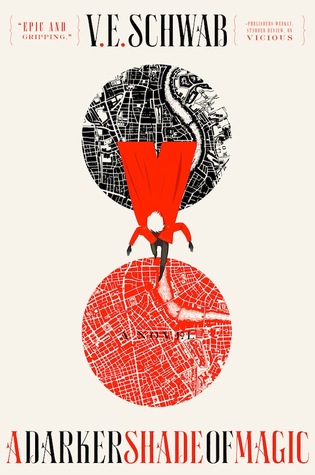A DARKER SHADE
OF MAGIC
V. E. Schwab
~Book Review~
Warning! This review contains major spoilers! Read at your own risk!
THIS FANTASY NOVEL began full of whimsical phrases and magical delights! I was instantly
captivated by the wondrous world V. E. Schwab created in A Darker Shade of Magic, its clever banter and vivid world-building
reminding me Philip Pullman’s The Golden
Compass, J.K. Rowling’s Harry Potter,
and perhaps most applicable, Roger Zelazney’s The Great Book of Amber. Long ago, people used to be able to travel
between worlds using magic. Not in present day. Now the worlds have been sealed
off, and only the magicians known as Antari can travel between them.
Kell is one of
these Antari, identifiable because one of his eyes is entirely black. He
inhabits a world known as Red London, where magic still thrives and everything
smells of flowers. Kell is both royal messenger to the rulers of the two other
Londons and a smuggler, selling artifacts to the highest bidder. There is Grey London,
which is the equivalent of our world, “magic-less.” There is White London,
which smells like blood because its cruel and pitiless rulers, the Dane twins,
control all magic and brainwash their soldiers into serving them. Finally,
there is Black London, a warning to the other worlds, because its inhabitants grew
too greedy for magic and it consumed them all.
While the
fantastical concept behind Schwab’s storytelling was superb, unfortunately I
felt that the main characters failed to become more than stereotypical
archetypes. Kell throws jabs at the royals, reminiscent of time traveler Corwin
from The Great Book of Amber, but he doesn’t quite have Corwin’s instantaneous
and endearing charm. I liked Kell, but he wasn’t a memorable stand-out. Kell as
a smuggler seemed a shadow of Locke Lamora from Scott Lynch’s Gentlemen Bastard
Series; while both play the stereotypical smuggler with a heart-of-gold
character, Locke Lamora’s morals conflicted the reader as much as his charm
enchanted, and he became progressively more complex throughout the series.
Sadly, I did not feel this investment in Kell; he failed to stand on his own alongside
these two similar literary characters.
The same is true
of the other lead, “Lila.” She was introduced much too late in my opinion, and
plays the typical thief who forces Kell to accept her as a sidekick, and then
also falls for him entirely too fast. The biggest disappointment for me was at
the end of the novel, when Lila fails to kill Astrid and Kell steps up to kill
both Dane twins. Although entirely believable, because Lila has never faced
sorcerers of such power before, I do hope she develops her own powers and takes
down a main baddie without Kell’s help. Prince Rhys was nice and jovial, but
also didn’t stand out to me as a unique and complex character I would continue
to read the series for.
There were also
some random third-person viewpoints which seemed very unnecessary like
Parrish, when more time could have been spent developing Kell. However, the villains
were very strong. The Dane Twins Astrid and Athos were delightfully evil, like
something out of Alice and Wonderland, and I also enjoyed reading about
Holland as well. However, overall this book felt
original, and the idea of four different Londons is wonderfully enchanting to
explore. I just wish the main characters felt as original as well.
Recommended for
fans of: J.K. Rowling, Neil Gaiman, Philip Pullman
Upcoming Book
Review: Cruel Beauty by Rosamund Hodge

No comments:
Post a Comment
Note: Only a member of this blog may post a comment.